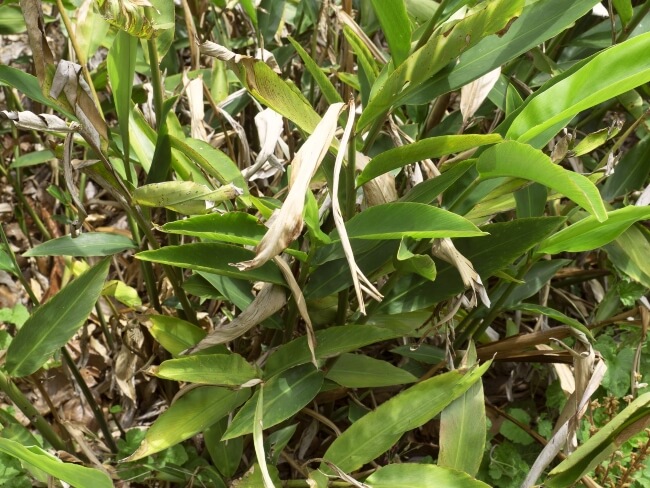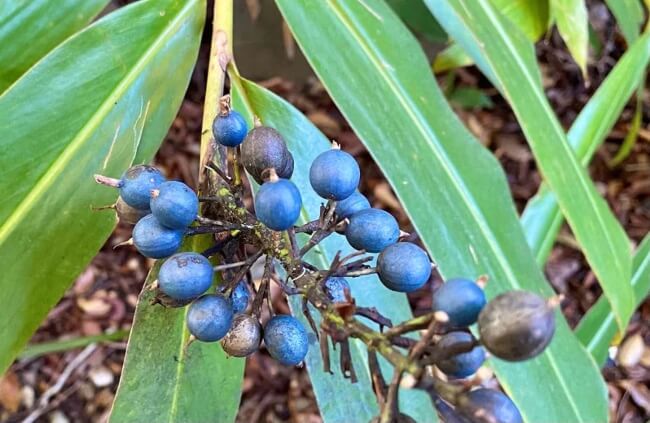We grew up with native ginger (Alpinia caerulea) in our garden. My parents called it blue ginger. This plant is beautiful, with shiny green leaves and bright blue berries. Our favourite part was eating the fruit with its tangy ginger taste.
This guide focuses on Alpinia caerulea, a plant that is easy to grow, looks great as a garden feature, and is helpful as a food source in the garden. Learn about propagation, plant care tips, and enjoying Australian ginger as bushfood.

Source: Australian Plants Society NSW
Family: | Zingiberaceae |
|---|---|
Genus: | Alpinia |
Species: | A. caerulea |
Common names: | Native ginger, Australian ginger, Red back ginger |
Origin: | Australia |
Location: | Indoor and outdoor |
Type: | Perennial herb |
Growth: | Up to 2 metres tall and 1 metre wide |
Sun requirements: | Full or part shade |
Foliage colour: | Dark green on the top side, reddish on the underneath |
Flower colour: | White |
Flowering: | Spring and summer |
Edible parts: | Roots, berries (just the flesh, not the seeds) |
Maintenance level: | Low |
Poisonous for pets: | No |
Introducing Alpinia caerulea
Australian ginger, red back ginger, or native ginger, is a valuable plant Aboriginal people use for food and creating shelter. The giant leaves are cut and used together to make a covering but are also wrapped around food for cooking.
Edible parts of the A. caerulea are the roots and the blue fruit. The root smells like ginger, and you can use it similarly. It adds divine flavour to savoury meals, desserts, and even tea! The blue berries are beautiful.
Their flavour is lemon ginger, and these berries are a thirst quencher for Aborigines to keep their mouths from drying out on long journeys.
Native Ginger's Natural Habitat
In a natural landscape, Australian ginger thrives in New South Wales and Queensland rainforest areas. From the end of spring and into summer, white flowers make an appearance.
They smell good, too. After the flowers come the berries, which can be picked and eaten straight from the plant. Its roots are easy to dig up when needed for cooking.
I love the shade, so Australian ginger is a plant after my heart. It loves shade and needs to grow in soil that stays moist. Add fertiliser in spring and mulch before summer arrives.
How to Grow Alpinia caerulea

Source: Pl@ntNet
How to Propagate Red back ginger
Native Ginger Propagation Using Seeds
Pick seeds from ripe red back ginger fruit and sow the fresh seeds as soon as possible. If these seedlings will be transplanted into the garden, you can use a standard potting mix. If your native ginger will remain in a pot, use a specialised native potting mix. It should be free-draining without too many nutrients.
Native seeds often have protective coverings, which can make germination challenging. Pre-treat A. caerulea seeds by soaking them to soften the coat so the new shoots pop through as they grow. Boil water and allow it to cool down for about 10 minutes. Put the seeds in the chosen container and cover them with water. Leave them overnight to soak.
After soaking, plant any swollen seeds and throw away any that float. Although the seeds are pre-treated, native plants generally take longer to germinate. Water the seed mix occasionally.
After germination, if the seedlings are being transplanted in the garden, do this before they are root-bound. The roots don't like to be disturbed, so take care during this process.
Australian ginger seedlings need regular water as they grow. Don't be too enthusiastic about applying fertiliser. Australian natives often grow in poor-quality soil. It's best to use a native-specific fertiliser when the seedlings are bigger and just a tiny amount.


Get Your Free Guide:
Master Growing Australian Natives eBook
A Must Have Complete Guide for Every Australian Garden
Get Your Free Guide:
Master Growing Australian Natives eBook
A Must Have Complete Guide for Every Australian Garden
Propagating Australian Native Ginger Using Division
Dividing up an A. caerulea is quite simple. Use a garden fork or similar tool to lift the plant from the ground and shake off as much soil as possible. Remove any dead leaves or flowers, and then pull the clumps apart.
If you're struggling, use a bread knife to help separate them. Each divided plant piece should have at least 3 shoots to give it the best chance of new growth. New clumps can be planted in the garden or established in pots in a sheltered spot and then transplanted when they grow.
How to Care for Australian Native Ginger
There's not much to ask in terms of care at all. A. caerulea grows to about 2 metres tall and 1 metre wide. It works well as a border plant or grouped with other plants. It does well in a pot, too.
- Pruning: Native ginger should be pruned when old leaves and flowers are visible. If the plant looks messy, prune to the ground if necessary. It might feel extreme, but new growth will arrive in its place.
- Water: A. caerulea likes moist soil. In summer, the plant needs water often and with generosity. In winter, you can water less. If the plant is wilting, this is a sign that it needs more water. Australian ginger is drought tolerant when it matures but will still need extra water in summer.
- Soil: Plant A. caerulea in soil with added compost and mulch before summer begins. The plant can handle most types of soil.
- Fertiliser: Feed Australian ginger often with an organic liquid fertiliser, especially during spring. This helps to boost growth and bear fruit.
- Sunlight: A. caerulea grows best in partial shade. Full shade is also fine, but the plant will produce less fruit.
Native Ginger Bush Tucker Guide

Source: Melbourne Bushfood
Native ginger fruit is perfect to harvest when the berries are a bright blue. This is when their flavour will be best. Berries can be picked straight off the plant. The fruit has many seeds, which shouldn't be eaten, but the fleshy pulp is tangy and divine.
Use it in both sweet and savoury dishes. Berries of Australian ginger can be used to add a sour note and red colour to herbal tea when dried and crushed.
When harvesting the roots, dig around the edge of the plant to get the new growth. This part of the root is the most edible and saves the plant from damage. Australian ginger and other underground roots are incredibly nutritious bushfood; this plant has plenty of vitamin B and minerals.
The end bits of the root can be enjoyed raw or cooked, depending on preference. If eaten raw, they're crunchy and have a mild flavour. Use the rhizome for cooking instead of ginger for a taste with less spice. It is delicious in a curry or marmalade.
Even the leaves of A. caerulea have a use in the kitchen. They are perfect for steaming fish and add a subtle ginger flavour.
Red back ginger Pests and Diseases
Spider mites
A spider mite infection can be spotted easily if you look out for 3 things. These include small white or yellow dots, webs on the leaves and stems, and a yellowing or browning colour in a specific part of the tree. This usually means a big infestation.
Kill off spider mites with 1 cup of rubbing alcohol and 4 cups of water. Create a spray solution and then apply it to the plant. Make sure to cover the entire plant well. The alcohol dehydrates the mites and kills them.
Mealybugs
These tiny pests give off a powder-like and waxy substance for protection. They can be seen quite easily on the leaves and stems of the plant and love warm and humid weather.
Mealybugs suck sap from the plant, which turns the leaves yellow, and they then fall off. If the infestation is bad, they can cause the growth of black sooty mould because of the wax they excrete.
Get rid of mealybugs with a strong water spray, or use rubbing alcohol dipped in a cotton bud to remove the bugs.
Fungal leaf spot
This fungus creates sections of green or yellow colour on the leaves. It looks dull at first but then turns brown or black. The shape of the leaf spot is usually oval or round but can be different.
Create a fungicide at home with a mix of liquid soap and water to spray the plant. Use one teaspoon of soap for every litre of water, then add a teaspoon of bicarbonate of soda to the mixture.
Alpinia caerulea Frequently Asked Questions

Source: Coolum Native Nursery
Is Alpinia a large genus?
It includes more than 250 species native to Australia and the Pacific. More specifically, there are 5 species in Australia, 4 of which are endemic to NSW and Queensland.
Where does the botanical name Alpinia caerulea come from?
Alpinia refers to Prospero Alpini, a 16th and 17th-century Italian doctor and botanist. His speciality was exotic plants, and he made some remarkable discoveries.
Caerulea is Latin and means 'blue', 'dark blue' or 'sky blue', referring to the colour of the plant's berries.
Can you grow red back ginger in a pot?
This plant will grow well in a pot. It must be sheltered from harsh weather and planted in a good-quality potting mix. A medium-sized pot is ideal.
Can you grow native ginger indoors?
It works well as an indoor plant if it gets enough water and nutrients. Sometimes, the plant might produce fewer flowers or fruit.
Will Alpinia caerulea grow in full sun?
This isn't recommended. The leaves burn quickly in harsh sun, and the plant and soil could dry out. If planting in a sunny place, add shade or plant the A. caerulea in a pot.
What edible roots is native ginger related to?
Native ginger (A. caerulea) is a member of the Zingiberaceae family, which also includes other plants known for their edible roots such as turmeric (Curcuma longa), our native turmeric (Curcuma australasica), and cardamom (Elettaria cardamomum).
Enhance Your Garden with the Exotic Allure of Alpinia caerulea
Lush and green leaves make Australian ginger a lovely feature plant. I recommend creating garden borders, framing a pool area, or filling in empty spots in the garden for a greater effect. When your Alpinia caerulea is at its best and flourishing, it can also be used for erosion control.
Published on February 8, 2025 by Gary Clarke
Last Updated on October 22, 2025





Hi,
could you tell me how long Australian Ginger seeds approximatly take to germinate?
Kind regards, Franziska
Hi Franziska,
Australian native ginger takes about 8 weeks to germinate. Sow it in early spring or autumn for the best results.
It can be sown all year round, but outdoor temperatures and light levels tend to be about right for pre-soaked ginger seeds either side of the hottest summer months.
Best regards,
Gary Clarke